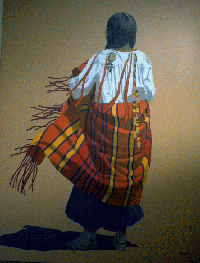

The American Indian

| Boz'o nikan! Ahaw nciwe'nmoyan ewabmInan. Iwgwien e'byayen ms'ote'. | (Greetings, friend. I am glad to see you. Thank you for your visit here.) |

Have you ever wonder what Indians were like? Well read on and you'll learn something new. The Sioux Indians were the first people to live in America. In 1776 there were two-hundred and fifty different tribes and each tribe lived in it's own way. They all ate different food, wore different clothing, played different games, and lived in different houses. By the 1880s there were 131 tribes living on the Great Plains alone! The Sioux tribe was the most famous tribe of all of the Plains Indians. The Sioux now live in North and South Dakota. Dakota is another word for Sioux.

The Sioux had light to deep brown skin, and their skin wasn't red as history would have you believe. Most of them were tall and thin and had thick, black hair that came down to their shoulders. Sometimes their hair was worn loose and sometimes it was in braids. They always liked to keep clean so they took baths often, after them, they would brush and part their hair with a porcupine quill brush. The Sioux slept on soft buffalo hides and they slept on the left side of the door. The right side of the door was for company. The Sioux lived in tepees made with tall sticks and buffalo hides stitched together. The tepee had only one room and the family was generally small; so there was room for everyone. The tepee was warm in the winter and cool in the summer so it was comfortable. The women were in charge of the tepees. The women working together could take a tepee down or put a tepee up in a few minutes.

They didn't live in one place all of the time, they always kept on the move, and they took everything with them. They never traveled in winter because it might be too cold or the snow too deep. They always traveled together. When they moved they put everything on a travois. A travois consisted of two poles tied like an X on an horse and smaller poles laid across which held everything. When they traveled the hunters and chief were in front and the women, children, and babies were in back. Boys who were one year old rode in front of their fathers to get the feel of riding. Older boys raced their horses and shouted and if they got carried away a member of the tokala would ask them to stop. The tokala were people chosen to keep order on the trip. Usually they didn't stay close to their tepees. They often visited the tepee of their second mother or second father. When babies were born the parents gave the child to another family to care for the child. The second father was chosen for a special talent to teach the boy. The second mother was chosen to teach the girl to be gentle, kind, responsible, and caring. The Sioux believed in sharing everything. When someone was tired, they got a tepee to sleep in, when they were hungry, they were fed, and when they were sad, someone listened to them and comforted them. Kinda makes one wish the world were still that way =)

They ate buffalo, buffalo, and more buffalo. Buffalo boiled, broiled, and sometimes raw buffalo. After a buffalo hunt there was enough to eat until the next hunt. In winter they made pemmican. After the hunt the women dried strips of buffalo, pounded it into a powder, added crushed berries and wild cherries with the pits, then added melted buffalo fat and stuffed it into a rawhide bag and got pemmican. They also ate a little of different meat like; deer, antelope, and bear. They ate wild fruit and vegetable because they were nomads and couldtn't spare the time to tend a garden. Men didn't always wear tall feather headresses, only a few men owned them and they only wore them on special occasions. The women didn't wear beaded dresses until the white men came because they didn't have beads until then. Before the white men came they decorated their clothes with elk teeth, bear claws, leather fringe, and porcupine quills. During a hunt in warm weather, the men wore a strip of leather called a breechcloth and a pair of moccasins. In winter men wore a buffalo robe with the fur inside. Men also wore two or three shirts, women wore two or three dresses. Winter moccasins were also lined with fur. Children didnn't go to any special school. They learned at work and at play. The best hunters and the best warriors were put in charge to teach the boys how to make an arrow, ride without a saddle, hunt, and steal a horse from an enemy. By the time a boy was five, he was a good rider, and by the time he was seven, he took care of the family horses. The best riders were picked to ride with the scouts, and to do errands for warriors in battle. Before a girl could get married, she had to know how to cook, how to make and repair clothes and tepees. She showed her skill by making clothes for her brothers. The very first lessons a baby learned was not to cry out loud. When the baby makes a crying sound the mother gently pinched, the baby's nose and covered the baby's mouth until they learned not to cry out loud. It was very important because what if your hurt during a hunt, if you cried out loud the buffalo would run away and the tribe would have no meat. If the tribe was hiding and you cried out loud you would give away the tribe's hiding place. Grownups didn't spank, yell, or lecture at their children, and the children learned for themselves that fire burns. Both boys and girls learned to swim before they learned to walk! Both learned how to ride horses at an early age, before they were five, they learned how to hunt small animals with a bow and arrow. After the age of five, girls did work like their mothers.
Has this helped you learn something about the American Indians?
If it has then you now know something about my ancestory....!
Still thirsty for more?! Here are more links that may interest you. Native American Links

